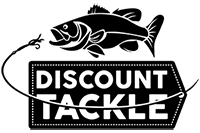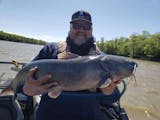
Senko: Origin, Uses, & Rigging Styles
By Discount Tackle Staff
Origin
The Senko soft plastic stickbait (aka stickworm) from Gary Yamamoto Custom Baits is one of the most popular, effective, and impactful bass fishing baits developed in the last 30 years. Developed by the brand’s eponymous founder, the Senko has a subtle, natural underwater action and versatile shape that allows it to be effective on a wide range of bait presentations and rigging styles. Today the term Senko has become so ingrained in the fishing lexicon that it has become synonymous with soft stickbaits in general, not just ones manufactured by Gary Yamamoto, and the Senko and similar baits are a go-to presentation for casual anglers and bass tournament professionals alike.
The origin story behind the Senko is some real American Dream material. In 1976, Japanese immigrant Gary Yamamoto purchased a campground in Page, Arizona adjacent to Lake Powell, an up-and-coming bass fishing hotspot that had been created a little over a decade earlier when the US government impounded the Colorado river with the Glen Canyon Dam. Yamamoto’s proximity to this fishery allowed him ample time to engage in one of his favorite activities: bass sportfishing. Interestingly enough, when Yamamoto’s passion for bass fishing led him to start pouring his own plastic baits in the early 1980s, he initially hoped to create a soft jerkbait like the Lunker City Slug-Go. Yet during testing, he discovered his design was much more suitable for slower, finesse presentations.
Yamamoto then spent time refining this new finesse design before selling it through his bait company: Gary Yamamoto Custom Baits. He traveled all around the Western US spreading the word about his product to tournament bass anglers and other bass fishing enthusiasts and quickly picked up a cult following in the West. The baits’ success in helping anglers catch more bass spoke for itself and by the late 90s, the Senko was a go-to presentation for anglers across the US and in Yamamoto’s home country of Japan as well.
Uses & Rigging Styles
Gary Yamamoto carefully designed the Senko to fall horizontally with a subtle undulating wiggle as it descends. During testing, Yamamoto found this to be more natural, and therefore more successful, when compared to the nose-down posture a majority of soft plastic baits assume as they fall. This falling action, combined with the ambiguous forage profile of the bait is what many, including Mr. Yamamoto himself, believe to be the secret to its success. Its motion is incredibly life-like and from a distance the bait’s profile resembles baitfish, leeches, insect larvae, nightcrawlers, and a myriad of other slender forage that bass consume. These characteristics make it incredibly effective on a wide range of presentations and techniques.
Wacky Rig
The Wacky Rig is one of the easiest and most effective rigs for the Senko and similar baits. To rig your stickworm Wacky-style you gently hold the worm using your thumb and index finger to determine the bait’s center of gravity. Once you have found it, push the point of a Wacky worm hook or octopus hook through the center of your lure, leaving the hook point exposed. A Wacky Rig O-ring may be used to help keep your bait securely attached to the hook.
Throw your rig adjacent to areas you think bass are holding. Bites will most often come during the fall, so if you make it to the bottom without hooking up, it's best to retrieve your bait and throw it to another area where it can repeat its signature undulating wiggle.
Split Shot Wacky Rig
The Split Shot Wacky Rig is exactly what it sounds like: the Wacky Rig described above, but with a split shot weight roughly a foot above your lure. This presentation is ideal if you’re fishing in water with current. It is effective because it mimics forage like hellgrammites and leeches, which both undulate as they swim. This is the reason the Wacky Rig works incredibly well in moving water: If you add a light split shot around up the line right from the bait, it will help the Senko in staying suspended just over the bottom. This also helps keep it in the strike zone considerably longer in both pockets and eddies and requires less casting and retrieving to create the signature action of the bait.
Neko Rig
The Neko Rig is another weighted variant of the Wacky Rig. This presentation, first developed in Japan, has you rig the worm Wacky-style and then add a nail or screw weight to one end of the worm so it can make contact with and hop around the bottom. Neko Rigs are a good choice when fishing deeper water, as the added weight helps the rig descend faster. Some companies, like VMC, even produce purpose-built hooks for Neko rigging soft plastic baits.
Texas Rig
Note that once you start to get into emergent or submerged trees and vegetation, then a Wacky Rig may start hanging up almost constantly. Weedless wacky hooks with wire or plastic weedguards are available, but they aren't totally reliable. For a reliably weedless presentation, we recommend Texas rigging with a worm hook or offset wide gap hook. A Senko can be Texas rigged with or without a bullet or nail weight sinker to adjust the bait's rate of descent. Texas rigs are ideal for when pitching or flipping to bedding fish or fish holding in the shallows near docks and grass beds.
Ned Rig
The Ned Rig or Midwest Finesse Rig has become another popular rigging choice for Senkos in recent years. See our previous Ned Rig blog post for full details, but essentially, this rig has you place half of a 5 or 6 inch Senko on a 1/32 ounce to 1/8 ounce mushroom-shaped jighead. Keep in mind that the rig is most suitable when you fish on any spinning tackle using a light line. You can shake it, drag it, and hop it. You can use many ways in order to retrieve it efficiently and effectively.

